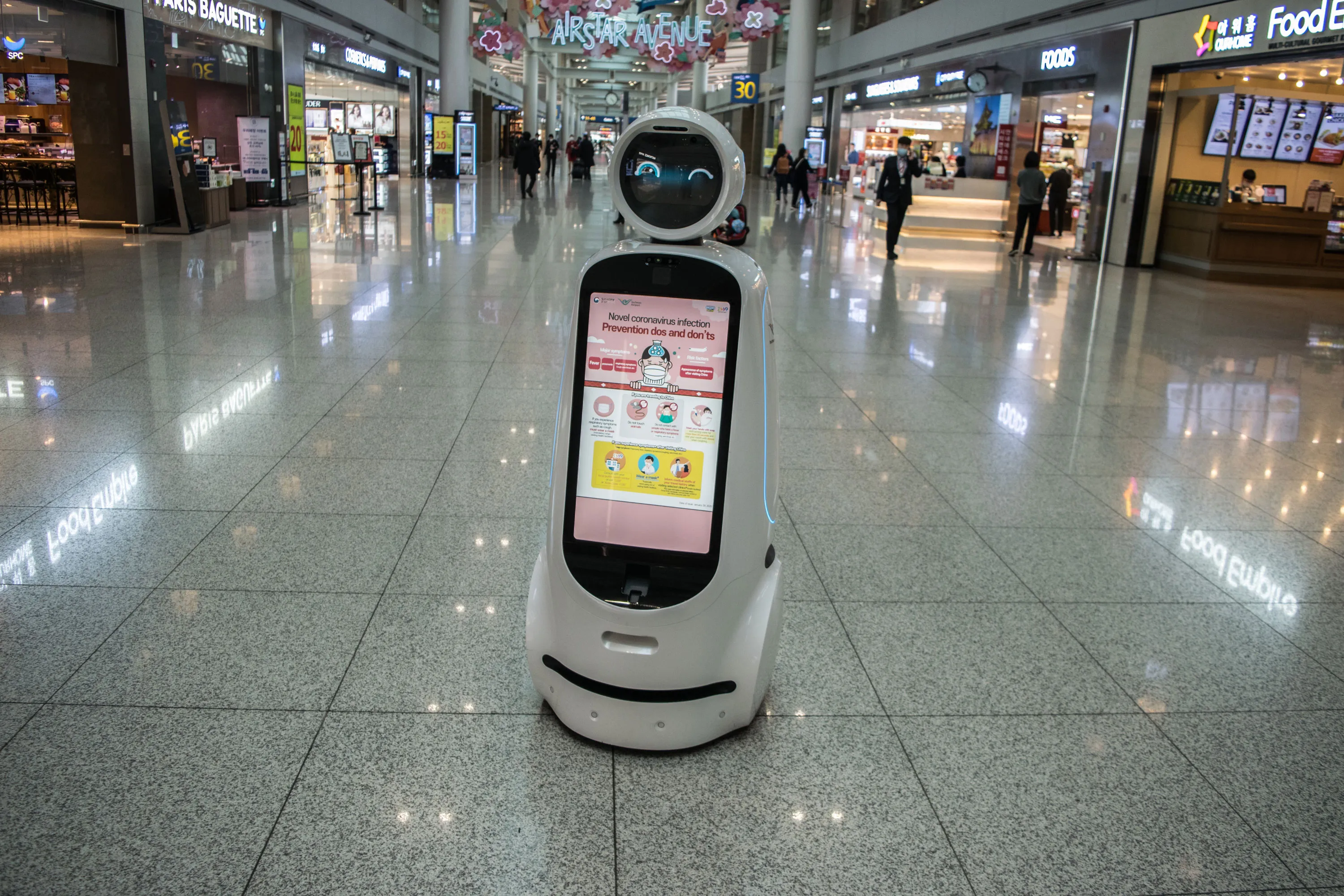Standards and Interfaces in Mobile Robotics
Laden Sie unseren Kalender herunter
Schritt 1:
Öffnen Sie Ihren Kalender in Outlook unter https://outlook.office.com/calendar.
Unter Windows können Sie auch Ihr Outlook-Programm nutzen. Die nötigen Schritte weichen dann ggf. leicht ab.
Schritt 2:
Klicken Sie auf Kalender hinzufügen und wählen Sie Aus dem Internet abonnieren.
Schritt 3:
Fügen Sie folgenden Link ein und klicken Sie auf Importieren.
https://outlook.office365.com/owa/calendar/d35c67af88f64628a6018dbceff8877f@synaos.com/8d78e80490b8462db720d7687cbe5c204542545792701501371/calendar.ics
Geschafft! Ab sofort profitieren Sie von unsere Events-Kalender und sind immer über die aktuellsten Intralogistik-Events in 2024 informiert.
Schritt 1:
Öffnen Sie Google Calendar unter http://calendar.google.com.
Schritt 2:
Gehen Sie in die Einstellungen und klicken Sie unter Kalender hinzufügen auf Per URL.
Schritt 3:
Fügen Sie folgenden Link ein und klicken Sie auf Kalender hinzufügen.
https://outlook.office365.com/owa/calendar/d35c67af88f64628a6018dbceff8877f@synaos.com/8d78e80490b8462db720d7687cbe5c204542545792701501371/calendar.ics
Geschafft! Ab sofort profitieren Sie von unsere Events-Kalender und sind immer über die aktuellsten Intralogistik-Events in 2024 informiert.
Wenn Sie kein Outlook oder Google Calendar nutzen, funktioniert das Hinzufügen des Kalenders ggf. etwas anders. Sie können diese allgemeinen Schritte befolgen, um unseren Events-Kalender Ihrem Kalender-Programm hinzuzufügen.
Bei Schwierigkeiten können Sie auch Ihre IT-Abteilung um Hilfe fragen.
Schritt 1:
Öffnen Sie Ihr Kalender-Programm.
Schritt 2:
Navigieren Sie zu der Stelle in Ihrem Programm, an der Sie einen Kalender hinzufügen können. Dies ist häufig in den Einstellungen oder der Menüleiste zu finden.
Schritt 3:
Wählen Sie die Option, bei der Sie einen Kalender aus dem Internet/per URL (oder ähnlich) abonnieren können und fügen Sie an der Stelle folgenden Link ein.
https://outlook.office365.com/owa/calendar/d35c67af88f64628a6018dbceff8877f@synaos.com/8d78e80490b8462db720d7687cbe5c204542545792701501371/calendar.ics
Geschafft! Ab sofort profitieren Sie von unsere Events-Kalender und sind immer über die aktuellsten Intralogistik-Events in 2024 informiert.

The international intralogistics scene is struggling to find interfaces and standards to harmonize mobile transport robots with central control centers. A German development is preparing to become a “world standard.” But is it even needed? We will take you on a trip around the world, where you will meet the various standards that currently exist. With our three management imperatives, you are well prepared if you want to automate your intralogistics now.
To successfully orchestrate heterogeneous robot fleets, an overarching communication system is needed. In intralogistics practice, this topic is called interoperability — this is likely to be really new to very few intralogistics practitioners.
The global intralogistics industry has been working for years on its form of universal communication interface, which should allow the steadily growing mass of robot fleets to be assembled flexibly and seamlessly using the “plug & play” principle.
What is behind “standardization” and “interfaces”?
But what exactly is behind the supposedly big and cumbersome topics of standardization and interfaces? At its core, this is quite banal informatics — namely the receipt and transmission of commands and status reports. In order for a central control center to mediate and orchestrate between different robots from different manufacturers, the formulation of the content must be the same at all points of data exchange. Put simply, what exactly means a U-turn, a stop or “my battery is empty” in the line of code to control the robots must be defined and standardized in advance.
If this standardization of language does not happen, error messages occur, processes stop, robots face each other without understanding and do nothing at all.
The aim of standardization initiatives is therefore: Establish a common machine language with which users can control heterogeneous mobile robot fleets from various manufacturers from a central control center — across the “mother tongues,” i.e. the proprietary software of robot manufacturers.
There is a clear business rationale behind the issue of interoperability
The business rationale behind this: Faster, more flexible start-ups, less economic dependence on individual manufacturers, problem-free scalability. <br>“Where the practical benefits at the technical development level have long been recognized, standardization initiatives have been formed worldwide. However, it is still difficult for decision makers at management level to understand the subject matter and to assess its suitability for practice. Errors, concerns, misjudgements and ambiguities persist — even with highly practical approaches such as VDA 5050,” explains Dr. Lennart Bochmann, CPO, CRO & Co-Founder of SYNAOS.

Reason enough to take a closer look. Once to travel through the currently rather confusing world of intralogistics. And also to answer the practical questions that have arisen after years of the boom in mobile robotics on the subject of interoperability.
The journey begins in Germany with the initiative that is currently considered a promising candidate to become an intralogistic “world standard”: VDA 5050.
“Errors, concerns, miscalculations and ambiguity persist — even with regard to already highly practicable approaches such as VDA 5050.”
Reason enough to take a closer look. Once to travel through the currently rather confusing world of intralogistics. And also to answer the practical questions that have arisen after years of the boom in mobile robotics on the subject of interoperability.
The journey begins in Germany with the initiative that is currently considered a promising candidate to become an intralogistic “world standard”: VDA 5050.
Europe, America, Asia: A short trip around the world through the state of affairs
At least the German-language intralogistics scene should VDA 5050 Be a household name by now. The interface was developed in cooperation between the Association of the Automotive Industry e.V. (VDA) and the Association of German Mechanical and Plant Engineering e.V. (VDMA) with support from the Institute for Conveyor Technology and Logistics Systems at the Karlsruhe Institute of Technology (KIT IFL).
What began with the idea of creating a universally applicable interface for communication between control centers and driverless transport systems (FTS) is now on the verge of establishing itself beyond the borders of its origin, the German mechanical engineering and automotive industries.
VDA 5050 is becoming increasingly popular — but must continue to develop
After five years of collaborative development among experts, and sometimes harsh criticism as regional, bureaucratic or creating “robot dumbdown,” the VDA 5050 capability is now a fixed criterion for tenders for robot fleets and control center systems. Manufacturers of intelligent Autonomous Mobile Robots (AMRs) are also increasingly making their devices “VDA 5050-ready,” even though the standard itself comes from the track-based Automated Guided Vehicles (AGV) world.
Andreas Scherb, conveyor technology and intralogistics consultant, driverless transport systems at VDMA e.V., is one of the brains behind VDA 5050. He says: “In the future, the system should also be opened up more and more to other mobile robots. Back then, we started with a technology stand that was dominated by AGV. In the short and medium term, we will address the topics of corridors and zones and thus enable autonomous vehicles to navigate freely within a certain framework. For example, on the right and left corridors, there are virtual guardrails within which a vehicle can move. But this feature will be optional. “<br>In one word: The VDA 5050 has become relatively established, but must be consistently developed in line with new technical developments. There is clear momentum for this from the German-speaking and Central European scene. Is the way now clear for the interface from Germany to become established all over the world? Yes.
Are Americans and Asians alienating with the “German Thing” VDA 5050?
Beyond all technical, practical and economically motivated arguments for VDA 5050: VDA 5050 is undoubtedly a success story that is currently being exported abroad by internationally active German companies. But it is already foreseeable: It will take a lot of persuasion to establish itself beyond the direct influence of the VDA 5050 community — in particular, these are primarily German automotive plants of German companies abroad. Because whichever way you look at it: Launched as a “German Thing”, American and Asian users with the VDA 5050 communication model will be more likely to alienate than use it euphorically.
If you look at industrial companies in the USA, the practical need for standardized communication seems to have already been manifested. With MassRobotics An interface comparable to VDA 5050 has been established from the east coast. That MassRobotics But direct competition with VDA 5050 is, as many still assume, is incorrect due to a different design and a different range of functions.
Who and what is really behind MassRobotics?

who MassRobotics As an interoperability standard, which means, strictly speaking, the MassRobotics AMR Interoperability Standard. Because with MassRobotics It itself is the non-profit organization of the same name from Boston, Massachusetts. That's why “measure.” It has existed since 2015 and aims to promote the development and use of robotic technologies in the USA.
Almost ten years after the company was founded, it goes without saying MassRobotics as a hub, acts like a mix of start-up incubator and think tank — broadly based with numerous event formats, mentoring programs, academic publications and practical dialogues.
The MassRobotics AMR Interoperability Standard: Only status information, no procurement
However, a standardization institute is MassRobotics At best, as a side job. The one presented for the first time in May 2021 MassRobotics AMR Interoperability Standard Although its goal is for robots from different manufacturers to be able to “talk to each other” via a common interface and standardized communication, it is limited to status updates and movement information. It is limited to parameters such as position, operating status, payload, planned routes and paths. The standard itself is more intended to connect robot fleets with adjacent infrastructure, such as warehouse management or ERP systems.
The MassRobotics standard explicitly does not represent a standardized transmission of transport orders from a central fleet manager to mobile robots. This means that a key feature for the operational operation of mixed fleets is missing. “Many see the MassRobotics standard as an American VDA 5050 and equate both standards in terms of content. That is not correct as it is. The MassRobotics interface covers a different scope,” says Dr. Philipp Schäfers, Head of Partner Management & Business Development at SYNAOS. “While the VDA 5050 was also explicitly designed to standardize the allocation of orders to the individual robots in a homogeneous or heterogeneous fleet, the MASSROBOTICS standard is limited to the exchange of information on status and movement. And there is another important difference: prevalence in industrial practice. In contrast to the MassRobotics standard, the VDA 5050 is operational — as numerous case studies show. ”

The MassRobotics standard explicitly does not represent a standardized transmission of transport orders from a central fleet manager to mobile robots. This means that a key feature for the operational operation of mixed fleets is missing. <br>“Many see the MassRobotics standard as an American VDA 5050 and equate both standards in terms of content. That is not correct as it is. The MassRobotics interface covers a different scope,” says Dr. Philipp Schäfers, Head of Partner Management & Business Development at SYNAOS. “While the VDA 5050 was also explicitly designed to standardize the allocation of orders to the individual robots in a homogeneous or heterogeneous fleet, the MASSROBOTICS standard is limited to the exchange of information on status and movement. And there is another important difference: prevalence in industrial practice. In contrast to the MassRobotics standard, the VDA 5050 is operational — as numerous case studies show. ”
“Many see the MassRobotics standard as an American VDA 5050. That is a mistake. ”
Standardization in Asia: No clear outlines to be identified
In contrast to America and Europe, standardization initiatives in Asia have so far only been vague. Anyone looking for practical examples of interoperability will find rather small-scale, more regional piecework.
For example, Changi General Hospital (CGH) in Singapore is using an 80-robot heterogeneous fleet of cute-looking AMRs called EDi, BlanKi and MedI. In hospital operations, they show visitors paths, hand out warm doilies to shivering patients and deliver medicines from the medicine cabinet to the wards. Connected to their environment, the robots open doors and travel independently with the elevator.
Singapore Changi Hospital: Robots drive elevator, distribute blankets
The technology in use: An interface specifically developed for the Asian healthcare market called “RoMi-h”. This is in turn based on the communication interface launched in October 2021 Open Robotics Middleware Framework, or in short: Open-RMF. Behind this is the so-called Open Source Robotics Foundation (OSRF), a non-profit organization created around Standford University. Their goal: to develop open-source software for use in robotics.
Who is with Open-RMF A little bit, he sees a concept that is fundamentally similar to VDA 5050. Auch Open-RMF It is about resolving the interoperability dilemma. Auch Open-RMF can map traffic management and task dispatcher functionalities according to its own statements, but is not designed, like VDA 5050, to control heterogeneous robot fleets beyond the robots' proprietary software.
Open-RMF: Very diverse applications, no intralogistics focus
The big difference to VDA 5050 is therefore that Open-RMF has not focused on intralogistics processes, which means that there is no depth of development with regard to the use of central control center systems. In fact, there is no such real development focus, except that new interface versions have focused in particular on the interaction of AMRs with physical intrastructures such as doors, escalators or elevators. Documented use cases essentially take place in hospitals, airports and shopping malls.

Japan and South Korea: Individual initiatives driven by robot manufacturers
Compared to the extremely service-oriented economy of Singapore and similar Asian metropolitan regions, the many traditionally industrialized economic structures of Japan and South Korea offer a wider range of intralogistic scenarios that would have to be solved through interoperability. In theory, at least.
Nevertheless, there are currently only isolated initiatives that are committed to a comprehensive standard. “This appears to be driven by one of the local mobile robot suppliers rather than a general industry issue,” says Tom Andersson, co-founder and principal analyst at STIQ Styleintelligence in London. Andersson and his team have for their report published in London in November 2023 AGV & AMR ROBOTICS researched all over the world.
STIQ report: Japanese robotics market is moving more slowly. Yet.
Remarkable: In the STIQ report, the representative of a Japanese robot manufacturer says: “Compared to the USA, the Japanese market is relatively slow in terms of demand for AGVs and AMRs. But I think this is changing due to the increasing labor shortage.” Almost paradoxical: When it comes to mobile robotics in intralogistics, Japan, which has been shaken by demographic change for years, is where Central Europe was presumably five years ago.

Lars Bäumann, who has learned about the Asian logistics market in detail in recent years as Chairperson Chapter Shanghai of the Federal Logistics Association (BVL), states: “Unlike in this country, Japanese companies only introduce automation when other options, such as humane resources, have been exhausted. They pursue much finer strategies. Risk management always plays a prominent role.” He adds: “If they see that processes work better with people, then they will continue to use people to do so. ”
And China? It's difficult.
And China? As a result of his work in Shanghai, Bäumann is probably as familiar with this market as few Europeans. He formulates a clear position: “If there ever is a standard, it will be an intra-Chinese for the domestic sector. In the foreseeable future, Chinese companies will not join a global standard such as the VDA 5050. ”
Whether there is currently a uniform Chinese communication interface for mobile robots? It's hard to say. Even though it can be heard that Chinese, Japanese and South Korean companies are occasionally making general inquiries about the VDA 5050 issue, the practice still seems a long way from really wanting to cooperate seriously.

As Executive Director Logistics, Dr. Susanne Lehmann has been responsible for over two years of Volkswagen's logistics strategy in China as well as material and vehicle logistics in ten Chinese factories. Her assessment is: “Chinese politics and the economy think very long-term and plan in cycles of up to 20 years. A nationwide, standardized communication interface was and has not been planned so far.” However, their team, together with Jiaotong University and in coordination with experts from SYNAOS, has set up a control system in order to create a standard at least within VW.
Management imperatives for a multi-speed intralogistics world
The journey in search of interfaces and standards for intralogistics takes you through a world of different speeds. However, one searches in vain for a world in which various national concepts fight for meaning and domination. Rather, the currently noteworthy standardization initiatives are strongly influenced by the “open source” concept, and also refer and recommend each other.
For now, this is good news for intralogistics practice. There are currently no foreseeable standardization struggles, as we know them from container shipping, the food industry or the transatlantic feud over the IFRS and US GAAP accounting standards.
What does this mean in practice? Which management imperatives can now be concluded?
#1: Don't wait for the world standard
Looking outside the box clearly shows that the German intralogistics scene has created something with the VDA 5050 interface that creates great practical benefits and economic value — far beyond its origins and homeland. When it comes to solving the increasingly urgent interoperability dilemma of mobile robotics, VDA 5050 is simply unrivalled worldwide. That is why now is the time to move forward boldly. Be it with a first step towards automation or in the form of a large mobile robot project. Withholding investments and decisions would be fundamentally wrong and will certainly result in falling behind.

It is far from being the world standard of intralogistics. However, a look at global industry shows that it doesn't have to be that at all. It would therefore be a mistake to wait until VDA 5050 — or a “global version” based on it — has established itself worldwide before making investments and decisions. <br>“There will be no global government of mobile robotics that will bindingly dictate to practice what lines of code look like and what they don't. What's the point? Intralogistics is not faced with a VHS Betamax decision in which you can bet on the wrong horse. Even though managers absolutely have to avoid bad investments, the biggest mistake right now would be to postpone investments where practical solutions already exist,” says Dr. Wolfgang Hackenberg, CEO and co-founder of SYNAOS.
“Even though managers absolutely must avoid bad investments, the biggest mistake right now would be to postpone investments where practical solutions already exist. ”
“If there is a world standard in the area of VDA 5050, then it is VDA 5050, which creates facts every day. Here and now, everything is there to go full throttle when automating intralogistics processes through mobile robot fleets,” says Dr. Wolfgang Hackenberg, CEO and co-founder of SYNAOS. “The biggest mistake right now would be to wait to make investment decisions when there are already a variety of successful solutions in practice. ”
#2 Don't understand standardization as a compulsion. But as a business case.
For many, the word standardization still sounds like petty gossip, lifelong bureaucracy and the curtailment of innovative wealth or entrepreneurial spirit. Mobile robotics, however, will be the case with just about any young industry that is consolidating after a period of booming growth: Standardised processes and practical interfaces will structure and accelerate growth. Reliability with regard to investments will increase, and performance and quality can be evaluated more accurately and comprehensively.
“In practice, using reliable, proven standards will simply ensure that less money goes through the fireplace. Where it is not clear which hardware can be perfectly orchestrated via which interface with which software, the result is almost always too large, incompatible fleets.” says SYNAOS CEO Hackenberg. Interoperability, he recommends, must be seen as a business case from management teams up to CFO functions. Not as an exercise in bureaucracy or unrealistic zeal for standardization.
Hackenberg continues: Standardised communication prevents bad purchases, speeds up commissioning and reduces dependencies on individual manufacturers. But that is only part of the business case behind interoperability. Deliver in terms of operational excellence central control systems such as from SYNAOS In addition, significantly more efficiency. More jobs are possible with fewer robots. ”
In addition, there is the global scalability of intralogistics scenarios once “solved” between different locations. If an intralogistics scenario is automatically in operation at location A, then decision makers would do well to apply this blueprint with comparable intralogistics scenarios at all their locations. This creates economies of scale in addition to the efficiency gains from automation. “And so, the bottom line is that an investment in intelligent intralogistics pays double dividends. If you see standardization as a value driver,” Hackenberg continues.
#3 Actively shape developments
It's almost a rush: But to a certain extent, (intra) logistics managers are faced with the choice of being drivers or driven by powerful standards.
The implementation of mobile robotics is a highly complex, business-critical task. The harmonization of hardware and software via standards requires a permanent balancing of technical achievements (such as autonomous navigation of robots) and their integration into comprehensively controllable control systems. It is not for nothing that the recent criticism of VDA 5050 was based not on technical impossibilities, but on scope for interpretation as to what the interface is able to represent and what new robotics and feature manufacturers are offering on the market in comparison. Cleverly avoiding obstacles, for example.
But even those who look critically at developer meetings and the voluntary approach, such as the VDMA, or consider it too slow should understand that standards are constantly evolving. And they develop all the more practicable and faster the more and the more active market participants participate.
“The development of the VDA 5050, for example, is currently focused on backwards compatibility, the embedding of autonomous navigation, load management and map formats. That there is so much on the note is a good thing! It shows that the industry is finding an ever wider forum in which those who really want to actively participate come together,” says Dr. Lennart Bochmann from SYNAOS.
A standardized interface between robots and control centers will prevail — but not for the sake of standardization
The search for greater efficiency, investment security and performance — that is the quintessence of standardization. The analysis of the current state of affairs shows that a standardized interface between robots and control centers will become established — but not for the sake of standardization. But through practical solutions for practice that prevail without anyone having to enforce them.
Photos: Frederike Wetzels; SYNAOS
Schließen Sie sich 1.000+ Intralogistik-Insidern an, die Insights direkt per E-Mail erhalten.

